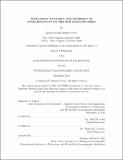| dc.contributor.advisor | Heidi M. Sosik and Michael G. Neubert. | en_US |
| dc.contributor.author | Hunter-Cevera, Kristen Rachell | en_US |
| dc.contributor.other | Woods Hole Oceanographic Institution. | en_US |
| dc.coverage.spatial | n-usn-- | en_US |
| dc.date.accessioned | 2015-01-05T19:34:01Z | |
| dc.date.available | 2015-01-05T19:34:01Z | |
| dc.date.issued | 2014 | en_US |
| dc.identifier.uri | http://hdl.handle.net/1721.1/92591 | |
| dc.description | Thesis: Ph. D., Joint Program in Oceanography/Applied Ocean Science and Engineering (Massachusetts Institute of Technology, Department of Biology; and the Woods Hole Oceanographic Institution), 2014. | en_US |
| dc.description | This electronic version was submitted by the student author. The certified thesis is available in the Institute Archives and Special Collections. | en_US |
| dc.description | Cataloged from PDF student-submitted version of thesis. "September 2014." | en_US |
| dc.description | Includes bibliographical references (pages 191-201). | en_US |
| dc.description.abstract | Synechococcus is a ubiquitous marine primary producer. Our understanding of the factors that determine its abundance has been limited by available observational tools, which have not been able to resolve population dynamics at timescales that match response times of cells (hours-days). Development of an automated flow cytometer (FlowCytobot) has enabled hourly observation of Synechococcus at the Martha's Vineyard Coastal Observatory (MVCO) since 2003. In order to ascribe changes in cell abundances to either growth or loss processes, information on division rate is needed. I refined a matrix population model that relates diel changes in the distribution of cell volume to division rate and demonstrated that it provides accurate estimates of daily division rate for both cultured and natural populations. Application of the model to the 11-year MVCO time series reveals that division rate is temperature limited during winter and spring, but light limited during fall. Inferred loss rates closely follow division rate in magnitude over the entire seasonal cycle, suggesting that losses are mainly generated by biological processes. While Synechococcus cell abundance, division rate, and loss rate demonstrate striking seasonal patterns, there are also significant shorter timescale variations and important multi-year trends that may be linked to climate. Interpretation of population dynamic patterns is complicated by the diversity found within marine Synechococcus, which is partitioned into 20 genetically distinct clades. Each clade may represent an ecotype, with a distinct ecological niche. To understand how diversity may affect population dynamics, I assessed the diversity at MVCO over annual cycles with culture-independent and dependent approaches. The population at MVCO is diverse, but dominated by clade I representatives throughout the year. Other clades were only found during summer and fall. High through-put sequencing of a diversity marker allowed a more quantitative investigation into these patterns. Five main Synechococcus oligotypes that comprise the population showed seasonal abundance patterns: peaking either during the spring bloom or during late summer and fall. This pattern strongly suggests that features of seasonal abundance are affected by the underlying diversity structure. Synechococcus abundance patterns result from a complex interplay among seasonal environmental changes, diversity, and biological losses. | en_US |
| dc.description.statementofresponsibility | by Kristen Rachell Hunter-Cevera. | en_US |
| dc.format.extent | 201 pages | en_US |
| dc.language.iso | eng | en_US |
| dc.publisher | Massachusetts Institute of Technology | en_US |
| dc.rights | M.I.T. theses are protected by copyright. They may be viewed from this source for any purpose, but reproduction or distribution in any format is prohibited without written permission. See provided URL for inquiries about permission. | en_US |
| dc.rights.uri | http://dspace.mit.edu/handle/1721.1/7582 | en_US |
| dc.subject | Joint Program in Oceanography/Applied Ocean Science and Engineering. | en_US |
| dc.subject | Biology. | en_US |
| dc.subject | Woods Hole Oceanographic Institution. | en_US |
| dc.subject.lcsh | Primary productivity (Biology) Measurement | en_US |
| dc.subject.lcsh | Biodiversity Monitoring | en_US |
| dc.title | Population dynamics and diversity of Synechococcus on the New England shelf | en_US |
| dc.type | Thesis | en_US |
| dc.description.degree | Ph. D. | en_US |
| dc.contributor.department | Joint Program in Oceanography/Applied Ocean Science and Engineering | en_US |
| dc.contributor.department | Woods Hole Oceanographic Institution | en_US |
| dc.contributor.department | Massachusetts Institute of Technology. Department of Biology | |
| dc.identifier.oclc | 898125375 | en_US |
